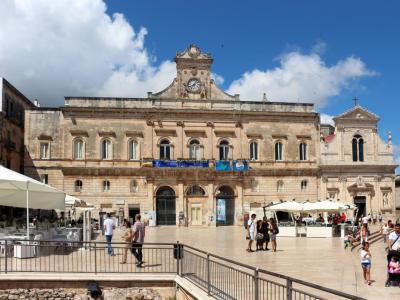
Palazzo del Municipio (Municipal Palace), Ostuni
The Municipal Palace in Ostuni, boasts a rich history that spans centuries, with its origins deeply intertwined with the city's religious and civic evolution.
Originally, the Municipal Palace was a Franciscan convent, nestled beside the Church of San Francesco D'Assisi. For over five centuries, from 1304 to 1809, it served as a serene residence for the Franciscan friars. The structure is characterized by two distinct levels: the ground floor housed communal spaces utilized by all the friars, while the first floor comprised individual rooms.
In 1813, during the Napoleonic era and amidst the suppression of monastic orders, the convent underwent a significant transformation. It transitioned into the City Palace, a purpose-built edifice intended to house the municipal administration.
During the period from 1861 to 1887, the main facade of the Municipal Palace underwent a modernization process under the guidance of architect Ferdinando Ayroldi. The neoclassical style adopted for this renovation aimed to harmonize the building's aesthetics with the adjacent Church. Since 1887, the former convent has functioned as the official seat of the city's municipality.
Upon entering the Town Hall, visitors encounter the charming cloister, constructed in 1739 under the guidance of engineer Pietro Magarelli. This tranquil space serves as a testament to the building's historical roots.
For those ascending to the first floor via a grand staircase, a visual delight awaits. Here, the works of artist Onofrio Bramante take center stage, offering a captivating depiction of the Historia Apuliae.
Originally, the Municipal Palace was a Franciscan convent, nestled beside the Church of San Francesco D'Assisi. For over five centuries, from 1304 to 1809, it served as a serene residence for the Franciscan friars. The structure is characterized by two distinct levels: the ground floor housed communal spaces utilized by all the friars, while the first floor comprised individual rooms.
In 1813, during the Napoleonic era and amidst the suppression of monastic orders, the convent underwent a significant transformation. It transitioned into the City Palace, a purpose-built edifice intended to house the municipal administration.
During the period from 1861 to 1887, the main facade of the Municipal Palace underwent a modernization process under the guidance of architect Ferdinando Ayroldi. The neoclassical style adopted for this renovation aimed to harmonize the building's aesthetics with the adjacent Church. Since 1887, the former convent has functioned as the official seat of the city's municipality.
Upon entering the Town Hall, visitors encounter the charming cloister, constructed in 1739 under the guidance of engineer Pietro Magarelli. This tranquil space serves as a testament to the building's historical roots.
For those ascending to the first floor via a grand staircase, a visual delight awaits. Here, the works of artist Onofrio Bramante take center stage, offering a captivating depiction of the Historia Apuliae.
Want to visit this sight? Check out these Self-Guided Walking Tours in Ostuni. Alternatively, you can download the mobile app "GPSmyCity: Walks in 1K+ Cities" from Apple App Store or Google Play Store. The app turns your mobile device to a personal tour guide and it works offline, so no data plan is needed when traveling abroad.
Palazzo del Municipio (Municipal Palace) on Map






Sight Name: Palazzo del Municipio (Municipal Palace)
Sight Location: Ostuni, Italy (See walking tours in Ostuni)
Sight Type: Attraction/Landmark
Guide(s) Containing This Sight:
Sight Location: Ostuni, Italy (See walking tours in Ostuni)
Sight Type: Attraction/Landmark
Guide(s) Containing This Sight:
Walking Tours in Ostuni, Italy
Create Your Own Walk in Ostuni
Creating your own self-guided walk in Ostuni is easy and fun. Choose the city attractions that you want to see and a walk route map will be created just for you. You can even set your hotel as the start point of the walk.
Ostuni Introduction Walking Tour
Perched atop a protective hill on the coast of Apulia, Italy, the picturesque town of Ostuni is a veritable maze, with a tapestry of houses upon houses, weaving together centuries of history that no map can adequately convey. In this intricate network of winding alleys, staircases, and arches, history and charm intertwine seamlessly.
The town's name, Ostuni, holds a mystique, with... view more
Tour Duration: 1 Hour(s)
Travel Distance: 0.7 Km or 0.4 Miles
The town's name, Ostuni, holds a mystique, with... view more
Tour Duration: 1 Hour(s)
Travel Distance: 0.7 Km or 0.4 Miles

